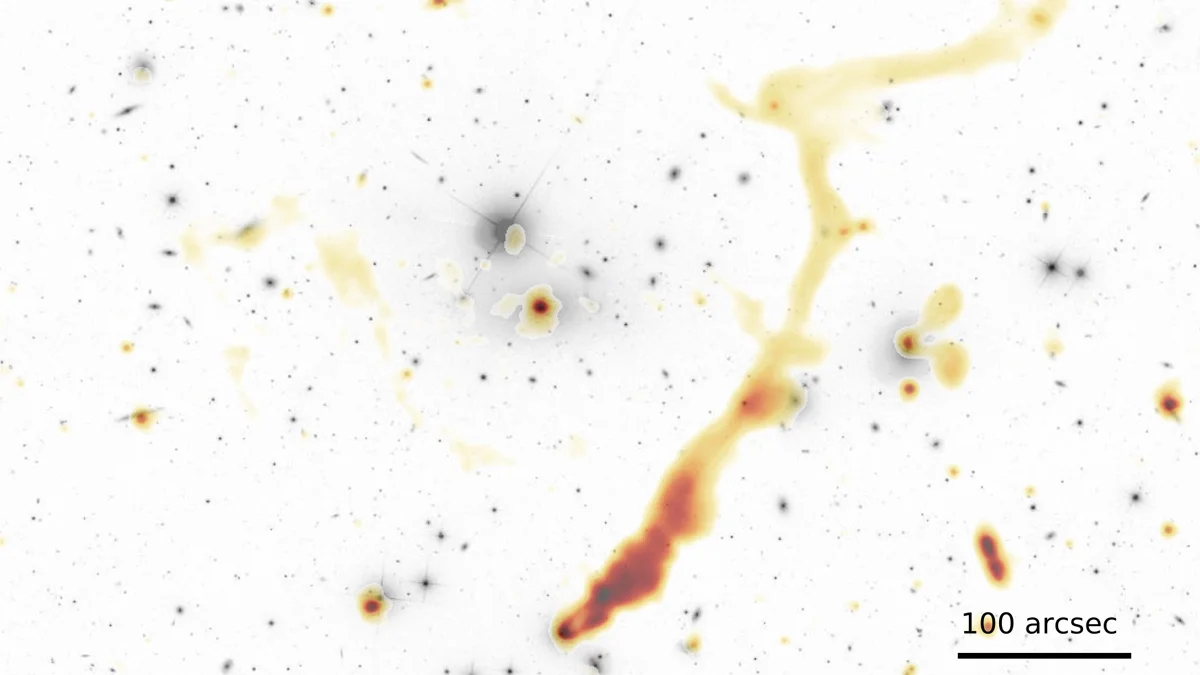
Radio map of the universe reveals 300,000 newfound galaxies
A global effort to map the night sky has yielded a bounty of nearly 300,000 new galaxies.
Astronomers from around the world have been probing the deepest reaches of our universe using LOFAR, an immense radio telescope that is scattered across Europe.
This new survey has scanned only one-quarter of the northern sky so far, but this release of just the first 10 per cent of the data collected by LOFAR has revealed something remarkable - nearly 300,000 previously undiscovered galaxies!
For the most distant object discovered in this new map of the universe, the radio waves detected from it by LOFAR had been travelling for over 12 billion years before they reached Earth. Based on an analysis of these radio waves, and knowing how the universe has expanded in the time since, the object that emitted them is estimated at being 26 billion light years away!
Zoom in on some of the objects spotted by LOFAR, to compare them in optical light and radio waves.
"This sky map will be a wonderful scientific legacy for the future," Carole Jackson, Director General of ASTRON, the Netherlands Institute for Radio Astronomy, said in a press release.

This map of the northern hemisphere sky shows the extent of LOFAR observations, as of May 2018. The green dots show the first results released, now, while red are unpublished observations, yellow are where observations are made between May 2018 and May 2020, and black dots are unobserved pointings. Credit: T. W. Shimwell et al.
WHY RADIO WAVES?
When observing the universe in visible light, objects are often missed. This is because matter (mostly dust) will intercept visible light photons travelling from distant objects, and also because the farther away an object is, the farther the light emitted by it will be 'redshifted'.
Redshifting happens as light travels through expanding space. The farther it travels, the more the wavelength of the travelling light is stretched. So, the farther away a blue star is observed, the more its colour will be shifted, to green, then yellow, then orange, then red. It doesn't stop there, however. Even farther objects will have their wavelengths shifted into the infrared, then microwaves, and the farthest will be redshifted into radio waves.
Thus, a telescope designed to collect radio waves, instead of visible light, can observe some of the oldest and most distant objects in the universe.
This is what LOFAR - the Low Frequency Array - does as it scans the sky.

The Low Frequency Array (LOFAR) spans Europe in different stations (pictured to the right), all of which act in concert to collect the longest wavelengths of radiation from space. Credit: Netherlands Institute for Radio Astronomy
WHAT DOES THE MAP REVEAL?
"In the evening when it is dark and we look up, we see stars. If we take a radio telescope and we look up at the sky, we see mainly emission from massive black holes. Those are giant objects located at the centres of galaxies," Huub Röttgering, one of the study co-authors from Leiden University in The Netherlands, said in an ASTRON video release.
"What we will study with LOFAR is the very first black holes," Röttgering added, "and we hope to answer the question: where do they come from?"
According to study co-author Philip Best, from the Univesity of Edinburgh, a supermassive black hole lies at the core of every massive galaxy, and these supermassive black holes are messy eaters, blasting out jets of material as they consume matter, and these jets show up at radio wavelengths.
"LOFAR has a remarkable sensitivity and that allows us to see that these jets are present in all of the most massive galaxies, which means that their black holes never stop eating," Best said in the ASTRON press release.
LOFAR is revealing more than just galactic supermassive black holes, though. The array is also allowing astronomers to observe what's going on between galaxies, as the matter there becomes stirred up into producing immense radio emissions by shocks and turbulence during galactic mergers, as weak magnetc fields that stretch across these intergalactic voids influence the radio waves passing through them from distant sources, and even other less obvious sources.
"What we are beginning to see with LOFAR is that in some cases, clusters of galaxies that are not merging can also show this emission, albeit at a very low level that was previously undetectable," Annalisa Bonafede, from University of Bolognaand INAF in Italy, said in the press release. "This discovery tells us that besides merger events, there are other phenomena that can trigger particle acceleration over huge scales."
With nearly 300,000 new galaxies detected in just the first 2.5 per cent of the northern night sky they've scanned, the project hopes to log a total of 15 million radio sources by the time it is complete.
"Just imagine some of the discoveries we may make along the way," Jackson said. "I certainly look forward to it."
Source: ASTRON | ASTRON YouTube






